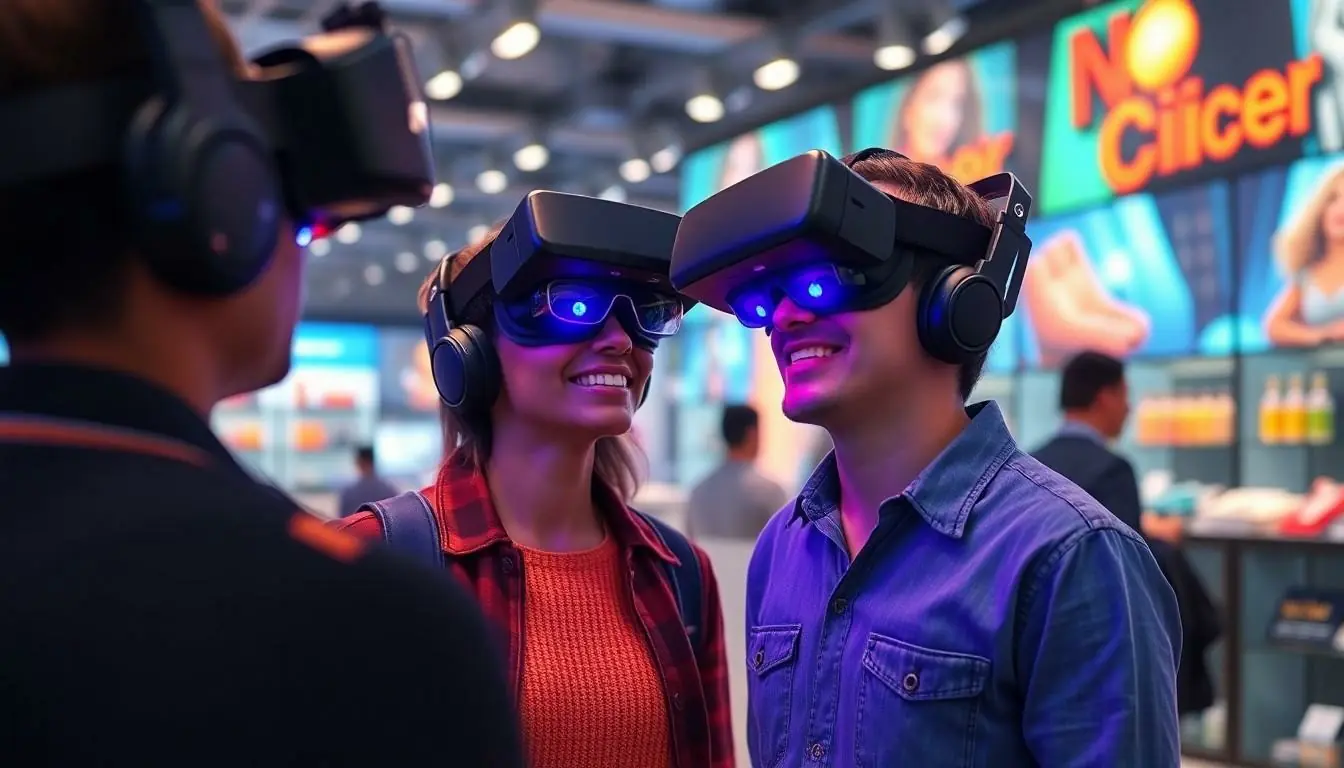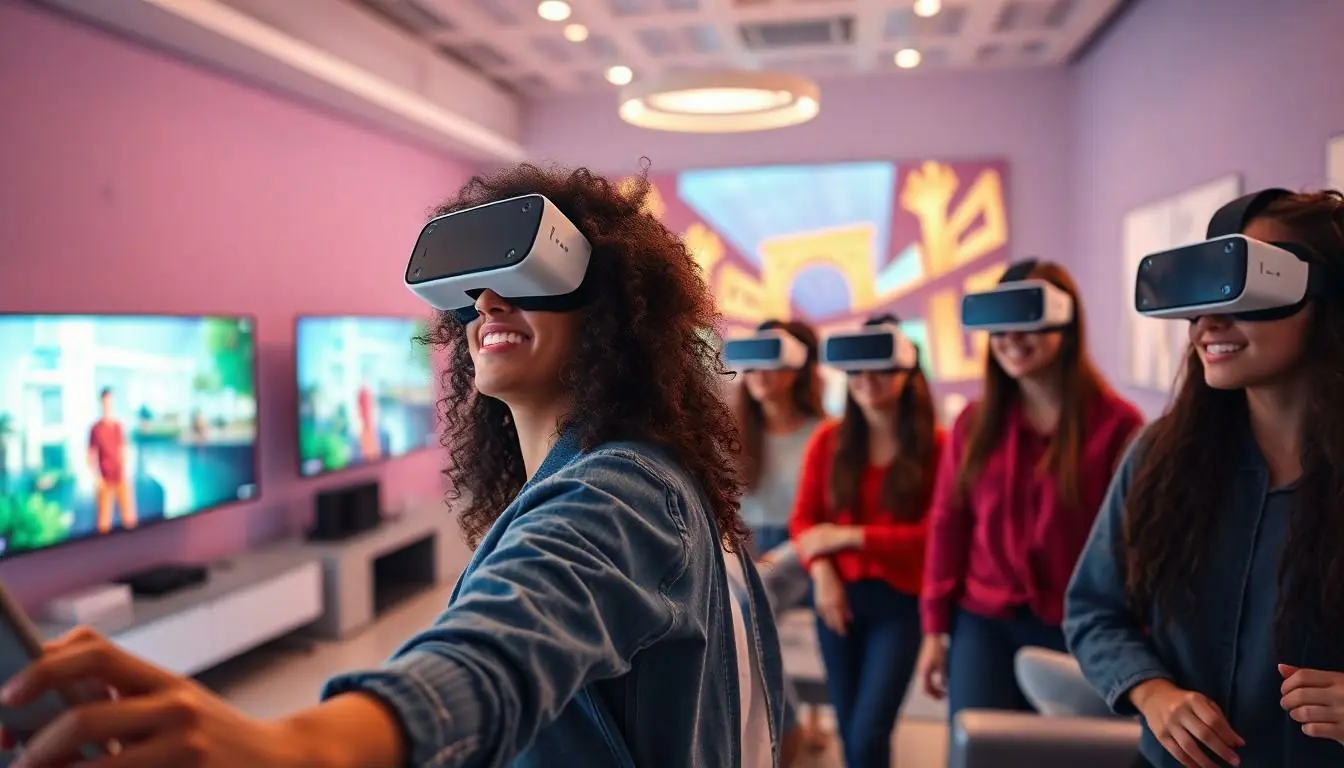Imagine stepping into a world where your brand isn’t just seen but experienced. Welcome to the realm of virtual reality marketing, where traditional ads take a backseat to immersive experiences that leave a lasting impression. Forget boring billboards and static websites; VR marketing lets brands transport consumers into their universe, creating unforgettable moments that resonate long after the headset comes off.
Table of Contents
ToggleWhat Is Virtual Reality Marketing?
Virtual reality marketing represents a burgeoning trend in advertising, utilizing immersive technology to engage consumers. This innovative approach enables brands to create experiences that allow users to interact with products and services in a virtual environment. By offering this level of engagement, companies stand out in a crowded market.
Potential customers can explore virtual showrooms, attend events, or participate in simulations, all designed to evoke emotional responses. Such experiences foster deeper connections between consumers and brands, surpassing the reach of traditional ads. Case studies show that interactive campaigns significantly improve consumer retention rates and brand loyalty.
Adoption of virtual reality marketing by various industries showcases its versatility. For example, real estate companies provide virtual tours of properties, enabling potential buyers to visualize spaces before visiting. Similarly, automotive brands allow customers to “test drive” vehicles virtually, creating memorable experiences.
Attention spans are shorter in today’s digital landscape. With VR’s immersive nature, brands capture audience interest in unique ways. Enhancements in technology, such as improved graphics and accessibility, make these experiences more realistic and appealing.
Marketers leverage data analytics within virtual environments to measure engagement and effectiveness. Insights gained from user interactions help refine strategies and maximize return on investment. Brands that embrace this technology gain a competitive edge by staying ahead of marketing trends.
Companies engaging in virtual reality marketing tap into the future of consumer interaction. This forward-thinking approach shifts the focus from telling to showing, creating memorable experiences that resonate with audiences. As technology evolves, the potential for innovative marketing strategies expands, paving the way for continued growth in this field.
Benefits of Virtual Reality Marketing

Virtual reality marketing offers numerous advantages that transform how brands engage with consumers. This innovative approach leads to unique opportunities for connecting with audiences in meaningful ways.
Enhanced Customer Engagement
Brands capture attention through interactive experiences that extend beyond traditional advertising. Engaging consumers in virtual environments enables deeper connections with products. Studies show that immersive campaigns increase emotional involvement, significantly boosting consumer retention rates. Customers enjoy exploring products at their own pace, enhancing satisfaction and familiarity. Through gamified experiences, brands encourage exploration, resulting in memorable interactions that stand out. Virtual reality marketing not only amplifies engagement but also drives consumers to take action, fostering loyalty and repeat business.
Immersive Brand Experiences
Creating immersive experiences allows brands to showcase their identity dynamically. Unique simulations and virtual scenarios highlight product features in engaging ways. Successful campaigns utilize environments tailored to specific audiences, ensuring relevance and resonance. Consumers experience a brand’s essence through virtual showrooms or interactive demos, enhancing emotional connections. These tailored experiences evoke emotions that traditional methods cannot replicate and lead to higher brand recall. By utilizing virtual reality, marketers show their products authentically and meaningfully, transcending traditional boundaries in consumer experience.
Key Technologies in Virtual Reality Marketing
Virtual reality marketing relies on cutting-edge technologies that enhance consumer engagement and experience. Essential tools and platforms drive this innovative approach forward.
VR Headsets and Equipment
VR headsets play a crucial role in immersive marketing. Devices like Oculus Rift, HTC Vive, and PlayStation VR provide users with multisensory experiences. Each headset offers unique features, catering to different marketing needs. High-quality visuals and spatial audio enhance interaction, making consumers feel present in virtual environments. Accessories, such as motion controllers, help users navigate these spaces seamlessly, further enriching the experience.
Software Solutions for VR Marketing
Various software solutions support the creation and execution of VR marketing campaigns. Platforms like Unity and Unreal Engine enable brands to develop interactive environments. These tools provide designers with the flexibility to customize simulations, optimizing user experience. Analytic tools integrated within software allow marketers to measure engagement metrics effectively. Such insights help refine strategies, ensuring that virtual campaigns resonate deeply with target audiences. Enhanced user interfaces promote intuitive navigation, encouraging prolonged interactions in virtual settings.
Successful Examples of Virtual Reality Marketing
Numerous brands successfully harness virtual reality marketing to enhance consumer engagement. IKEA created a virtual showroom allowing customers to design their living spaces with furniture in real-time. This innovation enables users to visualize how products fit within their homes, boosting purchase confidence.
Another effective campaign was conducted by the automotive brand Audi. Their virtual test drive experience places potential buyers behind the wheel of a new car without leaving their homes. Enhanced realism in the simulation significantly increases customer interest, making the decision-making process easier.
In the real estate sector, Coldwell Banker offers virtual property tours that allow prospective buyers to explore homes from anywhere. This approach saves time and enhances convenience, resulting in higher engagement rates and faster sales cycles.
L’Oreal incorporated virtual reality into its marketing by allowing customers to try cosmetics through a VR app. This immersive experience provides a unique way for consumers to test products, leading to greater brand loyalty and increased retail foot traffic.
The “The Walking Dead: VR Experience” by AMC represents an impactful intersection of entertainment and marketing. By immersing fans in the show’s universe, the campaign successfully builds excitement around new seasons while creating memorable interactions.
More brands are likely to adopt these innovative strategies as the VR landscape evolves. Each successful campaign underscores the potential of virtual reality to foster emotional connections, enhance user experience, and drive sales. The effectiveness of immersive storytelling lies in its ability to engage audiences meaningfully, demonstrating that creating memorable virtual experiences is a powerful marketing tool.
Challenges in Virtual Reality Marketing
Challenges exist within virtual reality marketing. By understanding these obstacles, brands can better navigate the complexities of immersive advertising.
High Production Costs
High production costs pose significant barriers to entry for many brands. Various factors contribute to these expenses, including the need for specialized equipment and skilled professionals. Creating high-quality virtual experiences requires advanced technologies, such as VR headsets and software platforms. Brands must also invest in content creation, which entails storyboarding, design, and programming. As a result, smaller companies may struggle to allocate sufficient budgets for VR marketing initiatives. Industry reports indicate that some VR projects can exceed $100,000, restricting access to larger enterprises with the resources to invest in virtual reality campaigns.
User Accessibility Issues
User accessibility issues hinder the widespread adoption of virtual reality marketing. Not all consumers possess advanced VR headsets or compatible devices, limiting the target audience. Furthermore, some individuals may experience discomfort or motion sickness when using VR technology. These challenges can discourage engagement and reduce the effectiveness of virtual campaigns. Brands have to consider the diversity of their audience and the technological gaps present among consumers. Solutions like developing mobile-friendly experiences can help capture broader segments of the market. By prioritizing user accessibility, companies can enhance the reach and impact of their virtual reality marketing efforts.
Virtual reality marketing is reshaping the advertising landscape by offering brands innovative ways to connect with consumers. As technology continues to advance, the potential for immersive experiences will only grow. Brands that embrace this shift can create memorable interactions that foster loyalty and enhance engagement.
While challenges like production costs and accessibility remain, the benefits of VR marketing far outweigh the obstacles. By focusing on tailored experiences and leveraging data analytics, companies can refine their strategies and maximize their impact. As the industry evolves, those who adapt to these immersive techniques will undoubtedly lead the way in creating deeper consumer connections.

